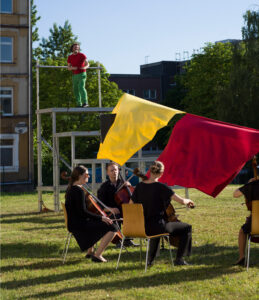Sonnenberg was built in the course of industrialisation in the 19th century as a residential area for the increasing number of workers who flocked to Chemnitz. Chemnitz was one of the richest industrial cities in Europe thanks to its numerous factories. However, the workers in the neighbourhood did not benefit from this. Up to 150 people lived in one house in very poor conditions. Social and hygiene problems quickly earned the neighbourhood a bad reputation. At the same time, it was very lively thanks to a large number of cinemas, theatres and ballrooms. Sonnenberg is still perceived as the socially deprived part of the city, a stigma that has been attached to it for decades. It also has the youngest average age in the city. A place where diversity and the associated tolerance play a major role. Due to its stigma, numerous houses have stood empty here since tens of thousands of people moved away after reunification in the 1990s.
The Solitaer e. V. club has appropriated these empty spaces and filled them with cultural life. Over the past nine years, the neighbourhood has undergone a very positive development thanks to private and public initiatives. The association’s cultural institutions such as LOKOMOV, the HINTEN gallery, the OFF-Bühne KOMPLEX stage, the studio houses and workshops, as well as other initiatives such as Nikola Tesla, Kaffeesatz and the Zietenaugust neighbourhood garden have made a significant contribution to the area’s revitalisation.
The first step towards sustainable urban development has been taken, which is reflected not least in the increasing number of residents. In the meantime, the district has also returned to the attention of the city administration, which is focusing on upgrading the neighbourhood through the emerging cultural and creative industries. The gentrification, increasing influx and corresponding rental price developments are already pointing to future issues such as displacement and property speculation.
The neighbourhood has also been in the national headlines due to radical right-wing underground structures. The so-called Right Plenum attempted to appropriate the neighbourhood with violent intimidation and media presence. These positive and negative developments were possible because for several years the Sonnenberg was a zone seemingly neglected by the city administration. The lack of prospects for the area on the part of the administration and the property industry created a niche that was exploited not only by the right-wing, but also by various liberal cultural actors.
There is no street fight raging over this empty space on the Sonnenberg, as it sometimes appears in press reports. For the most part, the neighbourhood is very harmonious. However, there is still a competition for the neighbourhood’s interpretation sovereignty. Klub Solitaer e. V. views art and culture in a socio-political context.
The club’s diverse cultural offerings do not just take place in one place, but have a decentralised effect on the district. The public space is thus revitalised and tested. Urbanity cannot be forced – it grows out of the undefined – where no one has officially planned it. This is still the great potential of southern Sonnenberg. Here, the city can develop from below.



